|
© Michelle Chan May has a special place in my heart, as it is both Asian American & Pacific Islander (AAPI) Heritage Month and Mental Health Awareness Month. With all that has been happening in the United States and around the world lately, I purposely chose May to publish my first children's book. During this special month, I wanted to gift others a book that touches on both of these topics. So please, join me in celebrating the month of May by reading this book with me and sharing it with others who may benefit from hearing its messages! The Backstory When I was just starting in my therapy career as a new graduate straight out of my masters program, I worked for a non-profit agency. The non-profit agency specialized in the care of children, teens, and their families. I found myself repeatedly talking to clients about the need to set boundaries. It was through these constant discussions that I realized how many children and teens were missing these important life lessons. One day, while I was spending quality time alone with my God-daughter, we had a talk during our car ride. She was in elementary school at the time, and I found myself trying to teach her about boundaries in a way that she could understand and wouldn't potentially scare her. So, I used the analogy of an invisible bubble. We talked about how there was a bubble around her. That the bubble’s size changed depending on where she was at, who she was with, and what she felt inside. She was definitely a smart cookie, because even as a young child, she was able to understand how the bubble was meant to protect her and let her know when she should ask for help! While that conversation happened quite a few years ago, and my God-daughter is now a teen, our conversation about the bubble stuck with me. So last year, when the memory of this conversation popped up in my mind (again), I again wished how more children could be taught this same message. I tried looking online for a book that talked about setting boundaries in this way for my young clients, but no matter how much I searched, I just couldn’t find it. And slowly, my wish of spreading this message led me to the idea of writing a children’s book myself. I wanted to create a story that was not only fun to read and enticing to look at, but also shared some important messages. Details, Details, Details "My Invisible Bubble" is a 8”x10” rhyming children’s book with illustrations that are beautifully detailed and colored. The main character in the book is an Asian American little girl, and she is surrounded by characters of different ethnicities. It was important for me that this book feel inclusive and representative of the wonderful world we live in. As many of us know, representation is so important, especially for young children. Throughout the book, the little girl wears many different outfits, so that young children know that there are many aspects and dimensions to each of them, and that it is more than okay to show that to the world! My Why This book was born out of a labor of love and a deep desire to make sure that as many children as possible hear the messages this story has to share. This story is a wonderful way for parents, caregivers, teachers, and/or therapists to start a conversation with children about identifying their feelings, learning to trust their own instincts, expressing their needs, and setting healthy boundaries with others. As many of us know, being able to set boundaries with others is an important way of being self-aware and for self-protection. The Hope This is a great book to be read again and again by caregivers to young children, to allow them an “in” to having ongoing conversations about boundaries. At the core of it all, it is to help children build a foundation in which they know their feelings are valid, and what they need to feel safe should be respected. May this also be a reminder to adults and caregivers that children’s needs should be taken into great consideration and care. "I have an invisible bubble around me; It protects me wherever I go. Even though you can't see it, It is always there, I know." -Michelle Chan, LMFT
0 Comments
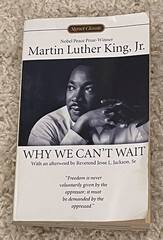 © Michelle Chan More than a year and a half ago, pre-COVID, I saw a pop-up selling used books in the middle of the mall. It was there that I came across this book by Dr. Martin Luther King Jr., “Why We Can’t Wait.” Like most, I had only learned briefly about who Dr. Martin Luther King, Jr. was. That he was a major leader in the Civil Rights Movement in the U.S., and that he used nonviolent protests and civil disobedience as the means to work towards obtaining equality and abolishing racial discrimination. Oh, and of course, his famous “I Have a Dream” speech. I realized that instead of reading about him, I can actually read and “hear” from him directly. This year, as a result of my personal goal to revive my childhood love of books, I finally made time to dive into this work by Dr. King, Jr. With all that has been happening or surfacing in the U.S. over the past year (e.g. COVID-19, murders of African/Black Americans by the police, white supremacists rioting at the Capitol, hate crimes and attacks on Asian Americans, etc.), Dr. King, Jr.’s words stung. Terribly. As a child, I was under the impression that racial discrimination was a thing of the past. Something that we as a society had learned and evolved from, and would never repeat again. It pained me greatly to read the words of Dr. King, Jr., from almost 6 decades ago, and have it still ring so true in 2021. In the book, Dr. King, Jr. mainly focused on what he did to end racial discrimination in Birmingham, Alabama. According to Dr. King, Jr., it was “the most segregated city in America” (36) at the time. He wrote about his decisions, the risks that went along with it, and the mindset he had in making these decisions. In history books, it was made to seem that taking the course of nonviolence was easy. But did you know? It was an extremely organized effort that entailed volunteers being trained to respond in peaceful and nonviolent manners, no matter what was being done to them! For some reason, it wasn’t until I read the words of Dr. King, Jr. that I realized how incredibly difficult it is to not defend oneself when being threatened or harmed. It was also during this time that the Black/African American community's perspective changed, and that “going to jail was no longer a disgrace but a badge of honor” (16). This reframe helped protestors let go of the internal barriers that had been in place before. Dr. King, Jr. wrote about how the road to racial equality needed to be multifaceted. It was not enough to just focus on increasing voter registration to elect officials who believed in racial equality, or to win cases in court, or to protest. Rather, ALL were needed to make a concerted effort. For even if cases were won in court, if we simply wait for those in power to put it into effect, we may end up waiting for eternity. For change to occur, we must each individually make a conscious effort to ensure that we are pushing towards a future where we all have equal treatment. What Dr. King, Jr. and his comrades in the Civil Rights Movement did, not only benefited Black/African Americans and all those who identify as people of color (POC), but American society and the world as a whole. This brief blog post does not do justice to the words and wisdom of Dr. King, Jr. So, please read his words for yourself! On that note, I will end with some of my top 5 inspirational quotes from Dr. King, Jr.’s book: “Nonviolence is a powerful and just weapon. It is a weapon unique in history, which cuts without wounding and ennobles the man who wields it. It is a sword that heals.” (12) “Injustice anywhere is a threat to justice everywhere. We are caught in an inescapable network of mutuality, tied in a single garment of destiny. Whatever affects one directly, affects all indirectly.” (65) "Freedom is never voluntarily given by the oppressor; it must be demanded by the oppressed.” (68) “We who engage in nonviolent direct action are not the creators of tension. We merely bring to the surface the hidden tension that is already alive. We bring it out in the open, where it can be seen and dealt with.” (73) “A social movement that only moves people is merely a revolt. A movement that changes both people and institutions is a revolution.” (107) © Michelle Chan
What the month of May represents hit close to home and is my heart and soul. If you didn't know already, May is Asian/Pacific American Heritage month as well as Mental Health Awareness month. In the midst of COVID-19, what May represents seem more important than ever before, at least to me and the communities that I'm a part of. I have been deeply saddened by what I have heard and read, on the news and in social media, about the mistreatment and abuse of people of Asian descent. I have heard loved ones express increasing concern about their safety as they go about their daily lives (e.g. getting groceries, mailing things at the post office, being at work). Quite a few friends who are in the medical field have shared with me that they are purposely wearing their scrubs to run errands, in the hopes that it serves as a protective factor. I know they're not alone. Many people of Asian descent across the country, and the world, are being more cautious of where they go to get their groceries and run their errands. And not just because of concerns about COVID-19. Many have become hypervigilant when they go out, taking into consideration what neighborhoods certain places are located, looking to see who they're surrounded by, trying not to speak in any native tongues to loved ones and family members when others are around, etc. Blame is a dangerous and deadly game. No matter what the issue at hand is, blaming only leads to division among us, with no "winner" at the end. It only delays solutions from being found, and deprives us of the sense of support and community we all long for. If you are feeling as though you are more anxious or on-edge, experiencing nightmares, having flashbacks of other traumatic experiences, being more cautious or hypervigilant, feeling scared for the safety of you and your loved ones... Know that you're not alone in having these experiences. You are not "crazy." Our physical environment has a very real and direct impact on our mental well-being. Take notice and acknowledge these emotions and things you're experiencing. Engage in activities to help you release some of the nervous energy (e.g. meditation, exercise, art, etc). Reach out to loved ones. They may need you just as much as you need them. And of course, therapy is always an option worth exploring during this extremely challenging time. Your mental health is just as important as your physical health if you want to "be okay" through all of this. "The things that go unsaid are often the things that eat at you." - Celeste Ng |
Michelle Chan, M.A., LMFT Archives
May 2021
Categories
All
|
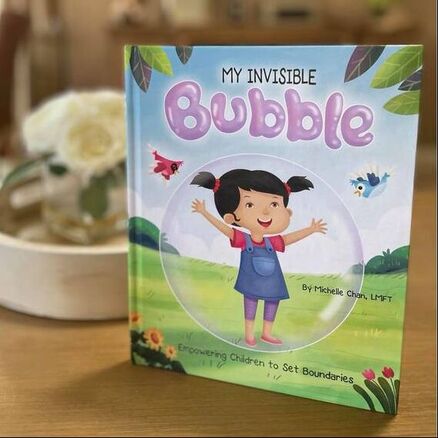
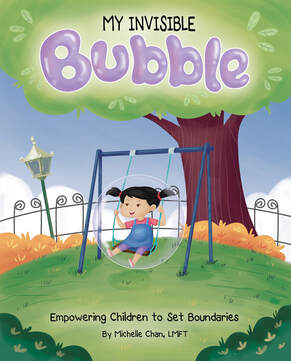
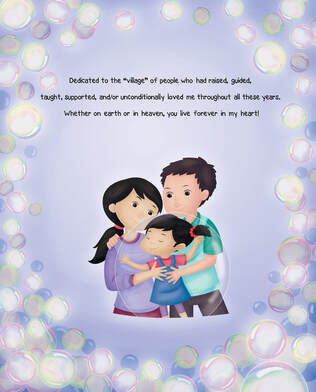
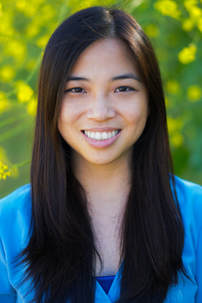
 RSS Feed
RSS Feed